You’ve likely struggled with granules that won’t stick properly or fall off during finishing work. Copper oxide transforms this frustrating experience by creating molecular-level bonds that actually hold. Its unique chemical composition lowers fusion temperatures while forming micro-textured surfaces that lock granules in place. When you understand how copper oxide’s properties work at the atomic level, you’ll discover why countless metalsmiths consider it irreplaceable for achieving consistently professional results.
Chemical Properties That Enable Effective Metal Bonding
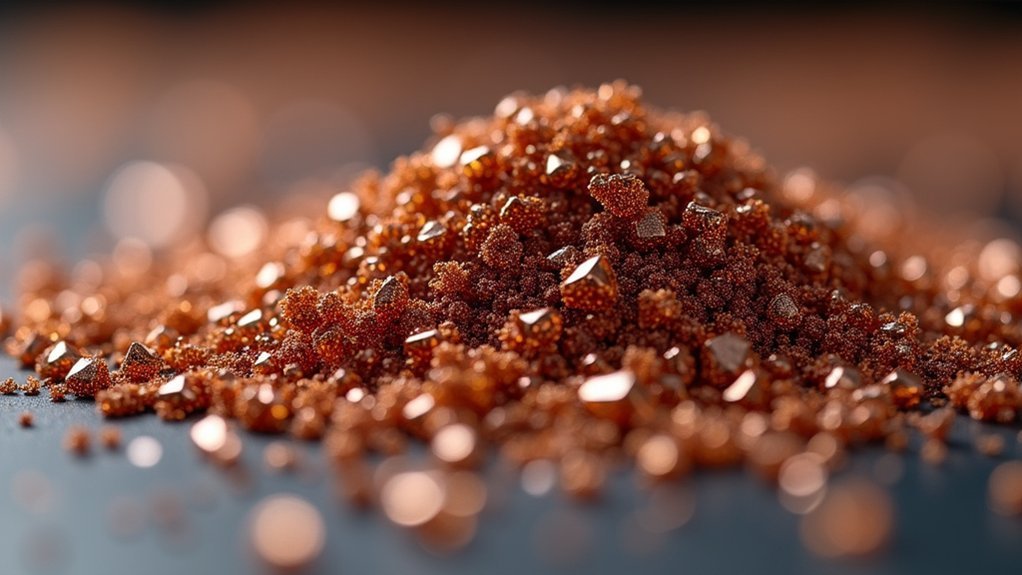
When you’re working with copper granulation, copper oxide’s unique chemical properties make it an invaluable flux agent that dramatically improves metal bonding.
Cuprous oxide lowers copper’s melting point, creating ideal conditions for forming eutectic alloy compositions that enhance molten metal flow and substrate adhesion.
You’ll benefit from copper oxide’s participation in redox reactions, which generates a favorable alloying environment and promotes strong intermetallic bonds.
The compound’s chemical structure creates a micro-environment with reduced oxidation potential, preventing harmful oxide formation that typically hinders bonding during heating.
Additionally, copper oxide accelerates copper atom diffusion rates, directly improving your final product’s mechanical strength and durability.
These combined chemical properties guarantee superior granulation results with enhanced structural integrity.
Temperature Control Advantages During the Heating Process
You’ll find that copper oxide’s lower melting point creates gradual heat distribution throughout your workpiece, preventing the sudden temperature spikes that can compromise granulation quality.
This controlled heating gives you enhanced flame control, allowing you to maintain steady temperatures without the risk of overheating that pure copper presents.
You can now make precise adjustments during the process, ensuring your granules bond properly without losing their structural integrity.
Gradual Heat Distribution
Although copper granulation requires intense heat to achieve proper fusion, controlling that heat’s distribution becomes the difference between successful granulation and ruined workpieces.
You’ll achieve superior results when you implement gradual heat distribution throughout your granulation process.
Controlled heating prevents localized overheating that can compromise your copper’s melting point and destroy granule integrity.
Here’s how proper temperature control enhances your work:
- Uniform surface heating – Creates consistent adhesion between copper and granules
- Steel mesh heat sinks – Minimize thermal shock while maintaining steady temperatures
- Slow heat ramping – Prevents oxidation and material degradation
You’ll find that maintaining steady flame control optimizes bonding quality while preserving your copper’s essential properties, resulting in professional-grade finishes every time.
Enhanced Flame Control
Since copper oxide possesses a lower melting point than pure copper, you’ll gain unprecedented control over your heating process during granulation. This enhanced flame control allows you to gradually increase temperature, creating ideal conditions for successful bonding between granules and your base metal.
The copper oxide’s superior thermal conductivity guarantees even heat distribution throughout your work, eliminating dangerous hot spots that could ruin delicate pieces. You’ll maintain precise temperature control while creating a controlled reduction atmosphere that enhances alloying.
| Without Copper Oxide | With Copper Oxide |
|---|---|
| Unpredictable heating | Precise control |
| Hot spots damage work | Even distribution |
| Lost granules | Protected integrity |
| Oxidation problems | Reduction atmosphere |
| Difficult bonding | Enhanced adhesion |
Your granulation process becomes more reliable and successful.
Creating Reliable Adhesion Between Granules and Base Metal
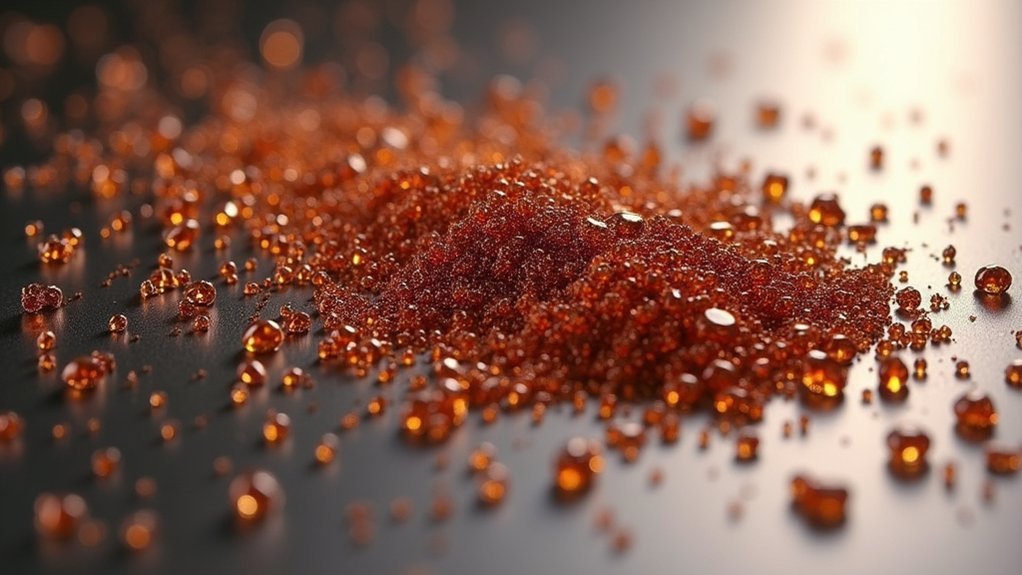
You’ll achieve stronger granule adhesion by understanding how copper oxidation creates microscopic surface textures that mechanically lock granules to your base metal.
When you apply controlled heat, the oxidized copper surfaces become chemically active, forming metallic bonds that fuse the granules permanently to the substrate.
This heat-activated bonding process works best when you’ve prepared both surfaces with a thin oxide layer that facilitates the molecular-level connection during heating.
Copper Oxidation Process
When copper undergoes controlled oxidation, it creates microscopic surface textures that dramatically improve granule adhesion to your base metal. The copper oxidation process transforms smooth surfaces into roughened landscapes that mechanically lock granules in place during soldering.
Here’s how to optimize your copper oxide formation:
- Apply controlled heating to promote surface oxidation while maintaining structural integrity of your base metal.
- Use a reducing atmosphere during heating to prevent excessive oxidation while allowing copper melting for proper granule fusion.
- Experiment with temperature variations to achieve the ideal oxide layer thickness for maximum adhesion.
Properly oxidized copper granules achieve lower melting points, ensuring effective bonding without compromising your base metal.
This copper oxidation process creates the foundation for successful granulation by maximizing surface contact between materials.
Heat-Activated Metal Bonding
As copper granules reach their melting point, they transform from solid particles into molten metal that flows and fuses directly with your base material. This heat-activated metal bonding creates exceptional adhesion through eutectic alloying, where the molten copper mixes with your substrate to form a durable connection.
You’ll need precise temperature control during this process. Overheating causes oxidation that weakens the bond, while insufficient heat prevents complete fusion. Using charcoal blocks creates a reducing atmosphere that minimizes oxidation and promotes stronger bonding.
Surface preparation dramatically improves results. Clean and roughen your base metal beforehand to give the molten copper granules better grip.
When executed properly, this technique produces superior bond strength that withstands stress and time.
Preventing Granule Loss During Finishing and Polishing
Because copper granules can easily detach during finishing and polishing operations, you’ll need to focus on proper bonding techniques from the start.
Copper oxide formation during granulation creates the foundation for strong adhesion, but additional steps guarantee success during the finishing process.
Consider these essential techniques to prevent granule loss:
- Prepare proper adhesives – Mix one part hide glue with ten parts distilled water to enhance bonding before polishing begins.
- Allow complete cooling – Don’t rush the dressing change by rolling granules off boards while they’re still warm.
- Choose sandblasting over aggressive polishing – This finishing technique creates unique textures without compromising granule integrity.
Steel sheets during granulation and controlled flame techniques also improve alloying, giving you stronger bonds that withstand polishing operations.
Optimal Mixture Ratios for Different Metal Applications

Proper bonding techniques set the foundation, but achieving granulation success depends heavily on mixing the right proportions for your specific metal type.
For copper oxide granules, you’ll need a base mixture of 10 parts distilled water to 1 part hide glue to guarantee peak adhesion.
When working with silver granulation, adjust your mixture ratios to 1 part copper oxide with 5 parts glue solution, adding flux drops for enhanced bonding strength during heating.
Gold granulation requires a different approach—use 1 part copper oxide to 4 parts glue solution for proper flow and fusion.
Consider adding small amounts of copper carbonate to strengthen bonding.
Always prepare fresh mixtures, as older solutions lose effectiveness and compromise granulation results.
Comparing Copper Oxide to Alternative Granulation Materials
When you’re deciding between copper oxide and alternative granulation materials, copper oxide stands out as the superior choice for metal joining applications.
You’ll benefit from its unique combination of properties that other materials simply can’t match.
Here’s why copper oxide excels in granulation:
- Enhanced biological activity – It promotes angiogenesis and collagen synthesis while stimulating extracellular matrix production for superior wound healing.
- Antimicrobial properties – You’ll prevent infections during granulation, creating a healthier environment compared to traditional materials.
- Lower melting point advantages – You’ll achieve easier fusing and bonding compared to silver or other metals.
Clinical studies confirm copper oxide’s effectiveness in accelerating granulation and epithelial tissue formation, delivering faster wound healing timelines than alternative materials.
Historical Context and Traditional Metalworking Applications
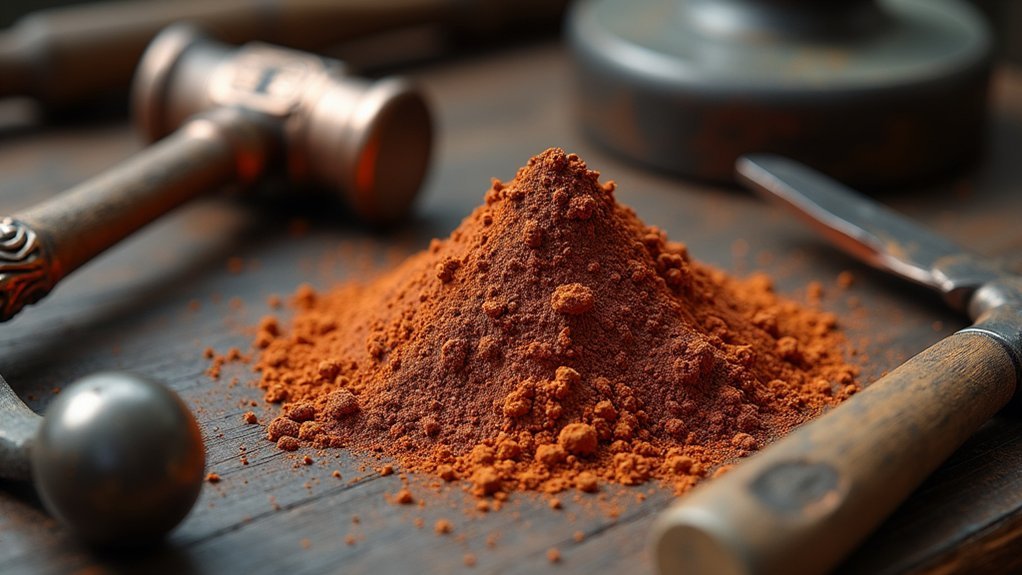
The advantages you’ve discovered in copper oxide aren’t new innovations—they’re rooted in thousands of years of metalworking tradition.
Ancient artisans, particularly the Etruscans, mastered copper oxide’s bonding capabilities in their sophisticated granulation techniques. They heated copper while incorporating organic glues mixed with copper minerals, creating a reducing atmosphere essential for successful metal fusion.
You’ll find these traditional methods produced remarkable decorative elements on jewelry that combined aesthetic beauty with superior structural integrity.
The mechanical properties of granulated pieces improved considerably through copper oxide application, while simultaneously creating the distinctive coloration and patination that defined ancient metalwork.
When you use copper oxide today, you’re continuing this rich heritage of metalworking excellence that’s proven effective across millennia.
Safety Considerations When Working With Copper Compounds
Although copper oxide offers remarkable benefits for granulation, you must prioritize safety when handling these compounds. Proper safety considerations include implementing adequate protective measures and following established protocols.
Essential safety measures you’ll need:
- Personal protective equipment – Wear gloves, goggles, and masks to prevent skin contact and inhalation.
- Proper ventilation – Maintain adequate airflow to prevent harmful dust or fume accumulation.
- Patch test – Conduct testing before extensive use since copper compounds can cause skin irritation in sensitive individuals.
You should store these materials in labeled containers away from incompatible substances and follow proper disposal methods to prevent environmental contamination.
Regular exposure monitoring in workplaces using copper compounds frequently helps maintain compliance with occupational health standards.
Troubleshooting Common Granulation Challenges With Copper Oxide
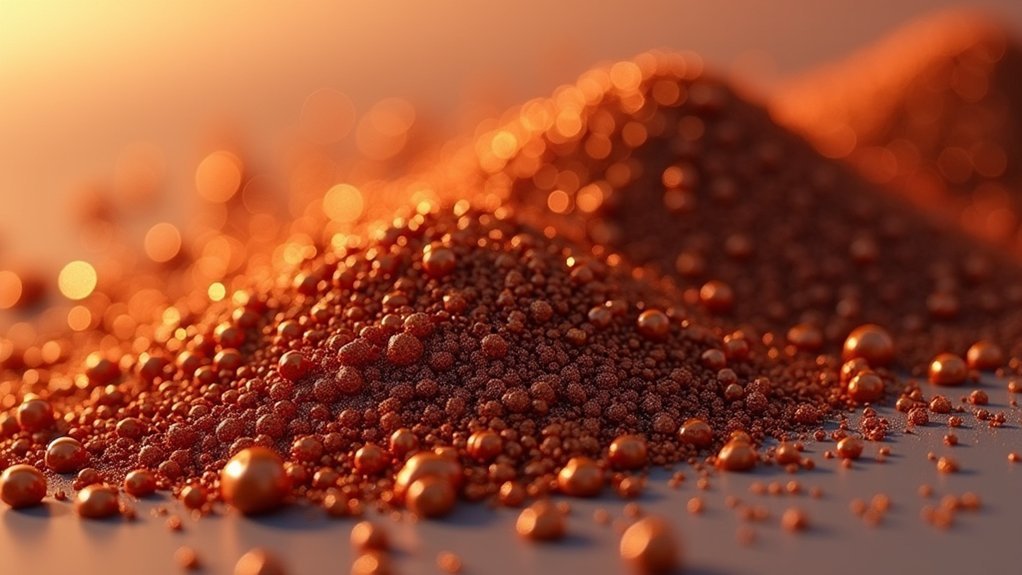
Despite following proper safety protocols, you might encounter specific granulation challenges that copper oxide can help resolve.
When granules fall off during firing, copper oxide’s superior adhesion and bonding properties create stronger connections between particles and your base metal.
If you’re struggling with inconsistent melting, copper oxide’s lower melting point compared to pure copper guarantees smoother fusing throughout the granulation process.
For issues with irregular granule sizes, copper oxide promotes more uniform granules by facilitating consistent alloying behavior.
These common challenges often stem from insufficient bonding between materials.
Frequently Asked Questions
Why Is Copper Important for Wound Healing?
Copper’s essential for your wound healing because it helps produce collagen and elastin, protects cells from damage, promotes new blood vessel formation, and accelerates tissue repair processes considerably.
What Is the Role of Copper Sulfate in Wound Healing?
Copper sulfate enhances your wound healing by promoting angiogenesis and collagen synthesis. It’ll fight infections with antimicrobial properties while stimulating fibroblast activity and keratinocyte migration, accelerating tissue regeneration and reducing healing time.
Why Was Copper Oxide Added in Excess?
You’d add copper oxide in excess to guarantee sufficient copper ions for oxidation-reduction reactions, enhance melting point for better fusion, improve surface quality, provide antimicrobial properties, and increase durability.
What Is Copper Oxide Impregnated Wound Dressing?
You’ll find copper oxide impregnated wound dressing is a multi-layer antimicrobial treatment containing cuprous oxide microparticles that reduces infections, promotes tissue regeneration, manages exudate, and remains effective for seven days.
In Summary
You’ll find copper oxide’s proven track record speaks for itself in granulation applications. Its chemical properties give you superior bonding while maintaining temperature control throughout your heating process. You’re getting reliable adhesion that won’t fail during finishing work, plus the flexibility to adjust ratios for different metals. When you’re troubleshooting granulation issues, copper oxide consistently delivers the molecular-level integration you need for professional results.

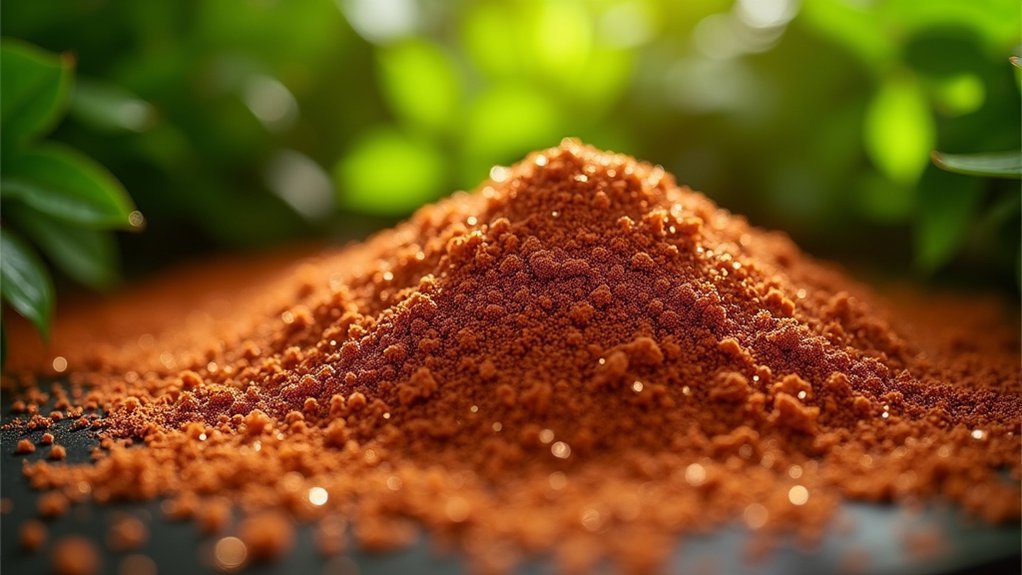

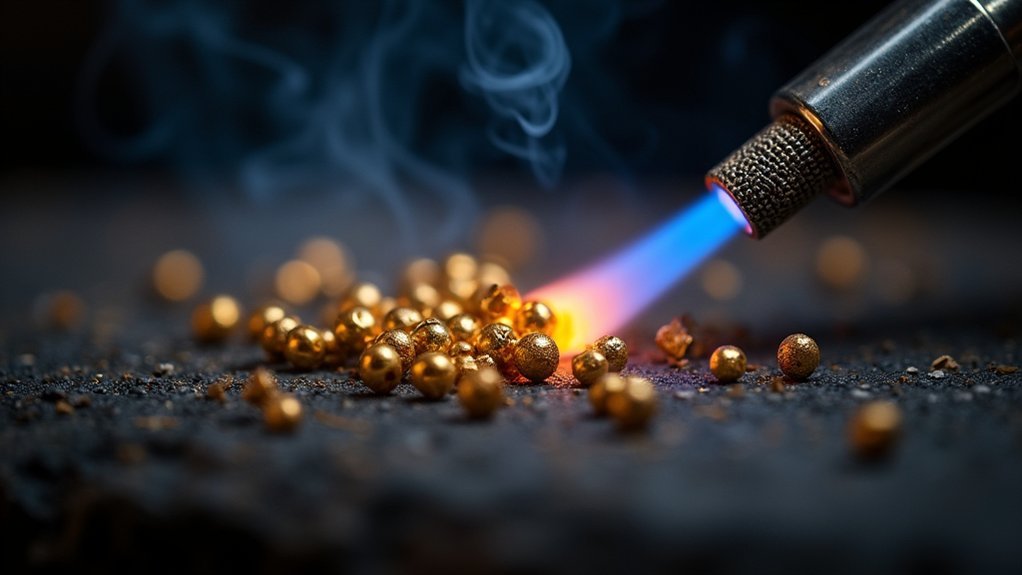
Leave a Reply